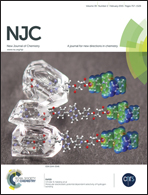Ultrasonic-assisted green synthesis of palladium nanoparticles and their nanocatalytic application in multicomponent reaction†
Abstract
This paper describes a novel one pot synthesis of palladium nanoparticles (PdNPs) using a green method. An aqueous extract of Perilla frutescens leaf was used as a bioreductant to reduce Pd2+ ions to Pd0 without any extra surfactants or capping agents. Polyphenols and flavonoids are believed to be actively involved in the reduction process. The formation of PdNPs was confirmed by UV-Vis spectra. Transmission electron microscopy revealed spherical nanoparticles, ranging in size between 10 and 17 nm (average ∼13 nm). X-ray diffraction revealed reflections from the (111), (200), (220), (311) and (222) planes confirming the crystallinity of the nanoparticles with a face centred cubic (fcc) structure. Energy dispersive X-ray spectroscopy confirmed the presence of palladium. Fourier transform infrared spectroscopy suggested the role of polyols present in the P. frutescens leaf extract. The synthesized nanoparticles were used as catalysts for the synthesis of pyrazolylphosphonate derivatives in high yield. The excellent catalytic performance of the synthesized PdNPs can be associated with their extremely small size and high dispersity, so the synthesized PdNPs will be applicable for future industrial processes.


 Please wait while we load your content...
Please wait while we load your content...